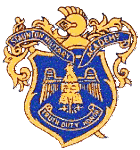Staunton Military Academy
| Staunton Military Academy | |
|---|---|
 |
|
| Location | |
| Staunton, Virginia | |
| Information | |
| Motto | Truth - Duty - Honor |
| Established | 1860 |
| Grades | (7-8 junior school) 9-12 |
| Color(s) | Blue and Gold |
| Information | 540-885-1309 |
| Disestablished | 1976 |
| Website | http://sma-alumni.org/ |
Staunton Military Academy was an all-male military academy located in Staunton, Virginia for much of its 116-year history. The school closed in 1976. Many notable American political and military leaders are graduates. A museum of the school's history is located on the Mary Baldwin College campus.
Charlestown Male Academy was founded in September 1860, by William Hartman Kable (1837-1912) at Charles Town, Jefferson County, Virginia (now West Virginia). At the start of the American Civil War William Kable joined the Confederate Army and served with distinction as a Captain in the 10th Virginia Cavalry (CSA). After the war, Captain Kable re-established his school at its original location. During this time period the school was known to the townspeople as The Kable School and its cadets were known as the "Kable boys".
In 1883, the school moved to Staunton, Virginia and became Staunton Male Academy. Captain Kable bought the site on the hill from a Mr. Alby, a prominent businessman. Acquisition of other large areas of land near the Alby estate continued until 1910. The school adopted the military system in 1886 and changed its name to Staunton Military Academy, or SMA, following by incorporation in 1893.
In 1900, Captain Kable turned over management of the school to his son, Colonel William Gibbs Kable (1872-1920). Colonel Kable proved to be very capable in school building and school management. He was a firm believer in advertising and used this medium extensively to bring the attention of the school to the public.
In November 1904, a fire destroyed the entire establishment, except for the founder's home and the old school hospital. Both barracks burned to the ground, but because of the brave and swift action of all involved, not a single life was lost. Following the fire, development of the campus was rapid: the South Barracks were completed in 214 days in 1905, the Mess Hall was constructed in 1913 on the site of the original mess hall, and the North Barracks were completed in 1918. By the 1930s, the campus also boasted Kable Hall, Memorial Hall, West Barracks, and the Superintendent's home.
...
Wikipedia
